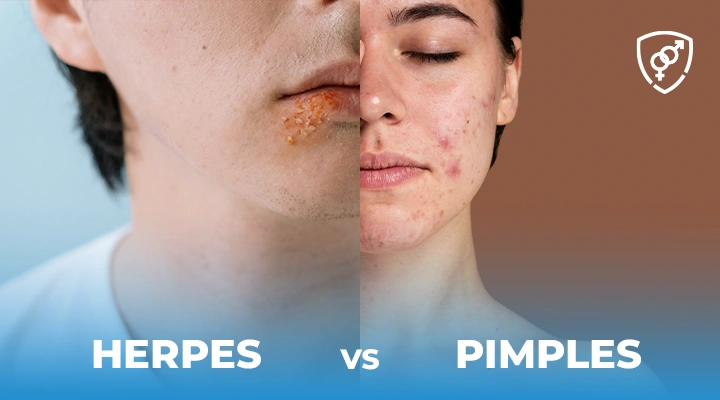Not sure if that bump is just a pimple or something more serious? Knowing the difference between herpes vs pimples can ease your mind or help you take the next step with confidence.
Skin issues near the mouth or genitals are common, but when a bump shows up after new or unprotected sex or feels a little “off,” it’s natural to wonder: Is this just a zit, or could it be something else, like herpes?
Let’s break it down clearly, so you know what to watch for and when to act.
Herpes vs Pimples: Key Differences
When comparing genital herpes vs pimples (or a herpes vs pimple on lip), here are the key differences to help you identify what you’re dealing with:
Pimples:
- Caused by clogged pores or ingrown hairs
- May look red or inflamed with a visible whitehead
- Typically not painful (though some can be tender)
- Heal within a few days to a week without scabbing
Herpes Bumps:
- Caused by herpes simplex virus (HSV)—a sexually transmitted infection
- Often start with tingling, burning, or itching
- Show up as fluid-filled blisters that burst, scab, and heal over 7–14 days
- Usually painful, especially in genital or oral areas
- Often appear in clusters, not just single bumps
How Herpes Looks and Feels
Wondering what does a herpes sore look like? Here’s what to expect if it’s HSV:
- Early warning signs: Tingling, burning, or itching even before any blister appears
- Appearance: Small, clear fluid-filled blisters—they can merge into larger sores
- Aftermath: Blisters pop on their own, leak fluid, and crust over
- Location clues:
- Around the mouth (oral herpes / cold sores)
- Genitals, inner thighs, buttocks (genital herpes)
- A single herpes sore is possible but less common, typically in early or mild outbreaks
Can Pimples Be an STD?
STD pimples are a real concern for many, especially when bumps show up in the genital area.
Here’s what to know:
If you’re dealing with unfamiliar bumps and not sure what’s causing them, a comprehensive STD panel is a smart way to rule out multiple STDs with a single test.
- Regular pimples in intimate areas can happen due to sweat, tight clothing, shaving, or follicle irritation.
- However, herpetic folliculitis—a lesser-known herpes presentation can look exactly like acne near hair follicles.
- Other STDs like molluscum contagiosum, syphilis, or genital warts can also mimic acne.
When to See a Doctor
Here’s your decision guide:
- The bump hurts, itches, or burns
- It’s recurring or came back in the same place
- It’s part of a cluster, or looks like a fluid-filled sore
- It burst on its own or developed a scab
- You’ve had recent sexual contact and aren’t sure about your or your partner’s STD status
Can you pop herpes?
Don’t. It spreads the virus, increases pain, and delays healing.
Instead, get tested. It’s fast, private, and clears up the guesswork.
At Manhattan STD Testing, we offer same-day appointments and confidential herpes testing because your peace of mind matters.
Conclusion
Pimples are harmless, clogged pores that heal quickly, while herpes sores are painful, fluid-filled blisters caused by a virus and often recur in clusters. If you’re unsure, professional STD testing is the best way to get clarity and peace of mind.
Frequently Asked Questions
Can stress cause herpes outbreaks or pimples?
Yes. Stress can trigger herpes flare-ups and also lead to acne due to increased oil production.
Is it possible to have herpes and not know it?
Yes. Many people have herpes without symptoms but can still transmit it.
Do herpes pop like pimples?
No. Herpes blisters burst on their own and shouldn’t be squeezed like pimples.
What can be mistaken for herpes?
Ingrown hairs, razor bumps, warts, molluscum, and syphilis can look similar.
Disclaimer
This blog is for informational & educational purposes only and does not intend to substitute any professional medical advice or consultation. For any health-related concerns, please consult with your physician, or call 911.

-
About The Author
Dr. Syra Hanif M.D.Board Certified Primary Care Physician
Dr. Syra Hanif is a board-certified Primary Care Physician (PCP) dedicated to providing compassionate, patient-centered healthcare.


